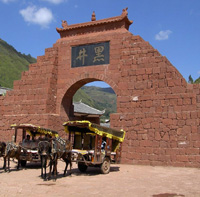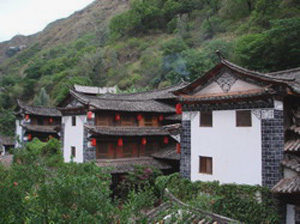| Tools: Save | Print | E-mail | Most Read |
| One Thousand Years of Salt |
| Adjust font size: |
A choice must be made, because you cannot possible walk and admire the view at the same time. So you dawdle, plotting your journey through the narrow streets on the far side of the river, picking out the steps that will lead you to temples clinging to the mountain opposite?ataller and steeper even than where you stand. Perhaps, as I, you will find yourself wondering why someone decided to put a railway line through the middle of it. It's easy to fall out of sympathy with modern ways when walking the old roads of Only five years ago, Heijing was a decaying relic, ripe for complete demolition. Its traditional salt industry was dead and its wealth was dissipated. Today, tourists travelling the railway and a fresh blacktop highway have given this ancient town a new lease on life, a new purpose. Old Money Before the Chinese Revolution, Heijing was the seat of At its peak during the Ming Dynasty (1368¨C1644), 67 percent of the salt taxes for the entire province were paid from this one place, whose merchant families built magnificent homes and patronized fine temples. Residents surrendered some of their wealth to the Red Army when it passed through the area in 1936. The most generous was also the wealthiest, a merchant named Wu Weiyang, who was afterward praised as a patriot by Red Army Commander-in-Chief Zhu De. Wu's ancestral home features calligraphy from the Qing Emperor Weifeng above its front door. Before its recent reincarnation as a hotel, the Wu family's grand residence had 99 rooms; no one is sure quite how many there are now; the family is long departed. But even in its post-renovation state, it's possible to learn a great deal about how the rich and their extended families lived and entertained under the ancien regime. A private stage for musical and theatrical performances has been restored and may one day host them again for up-market tourists. On wet days it's a simple pleasure to sit under its eaves while the rain splashes into the open courtyard a few inches below.
Salt with Everything
Non-guests need a ticket to look around Wu's old home, as this is the high-point of the official walking tour. No cars are allowed inside Heijing, where the only permitted form of transport is a horse-drawn cart. It is still a small town, with just a single main street running parallel to the Beyond that is a bumpy two-kilometre track leading to the Salt Museum, where salt is still produced for the edification of tourists and the satisfaction of traditional tastes: a cup of tea in Heijing is likely to include a dash of salt, while the town's signature dish is a salty chicken based on the fowl that workers once prepared in the factories' spare salt-roasting pans. It's a splendid museum with photographs covering 100 years of local history, but you will need to be with someone who can read Chinese to get the most out of it. The Sunday market reflects Heijing's current situation. Day-trippers and weekenders from Almost no tourists visit from Monday to Friday, so the town still has a life of its own, combining a strong sense of history with a pleasing lack of commercialization. Catch it while you can. (
|
| Tools: Save | Print | E-mail | Most Read |
 |
| Related Stories |
|
|
Product Directory China Search |
Country Search Hot Buys |

